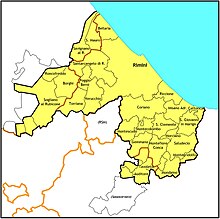Diocese of Rimini
|
Diocese of Rimini Dioecesis Ariminensis |
|
|---|---|

Rimini Cathedral
|
|
| Location | |
| Country | Italy |
| Ecclesiastical province | Ravenna-Cervia |
| Statistics | |
| Area | 781 km2 (302 sq mi) |
| Population - Total - Catholics |
(as of 2010) 346,604 318,876 (92%) |
| Parishes | 115 |
| Information | |
| Denomination | Catholic Church |
| Rite | Roman Rite |
| Established | 3rd century |
| Cathedral | Basilica Cattedrale di S. Colomba |
| Current leadership | |
| Pope | Francis |
| Bishop | Francesco Lambiasi |
| Emeritus Bishops | Mariano De Nicolò |
| Map | |
 |
|
| Website | |
| www.diocesi.rimini.it | |
The Roman Catholic Diocese of Rimini (Latin: Dioecesis Ariminensis) is an ecclesiastical territory in Emilia Romagna, Italy. It is a suffragan of the Roman Catholic Archdiocese of Ravenna-Cervia.
It has a surface of 781 km², extending over 28 communes of the area. It has 123 parishes and 303,365 Catholic inhabitants [1].
Bishop Francesco Lambiasi is the current diocesan bishop.
Rimini was probably evangelized from Ravenna. Among its traditional martyrs are: St. Innocentia and companions; Saints Juventinus, Facundinus, and companions; Saints Theodorus and Marinus. The see was probably established before the peace of Constantine.
Among the bishops were: Stennius, at Rome in 313; Cyriacus, one of his successors, sided with the Arians; under St. Gaudentius the famous Council of Rimini against Arianism was held in 359 (for over 400 Western bishops, parallel with the eastern bishops' council of Seleucia); he was later put to death by the Arians for having excommunicated the priest Marcianus; Stephanus attended at Constantinople (551); the election of Castor (591) caused much trouble to St. Gregory I, who had to send to Rimini a "visitor"; Agnellus (743) was governor of the city, subject to the Archbishop of Ravenna; Delto acted frequently as legate for pope John VIII; Blessed Arduino (d. in 1009); Uberto II is mentioned with praise by St. Peter Damian; Opizo was one of the consecrators of the Antipope Clement III (Guiberto, 1075); Ranieri II degli Uberti (1143) consecrated the ancient cathedral of St. Colomba; Alberigo (1153) made peace between Rimini and Cesena; Bonaventura Trissino founded the hospital of Santo Spirito; under Benno (1230) some pious ladies founded a hospital for the lepers, and themselves cared for the afflicted. At the end of the thirteenth century the Armenians received at Rimini a church and a hospital.
...
Wikipedia
